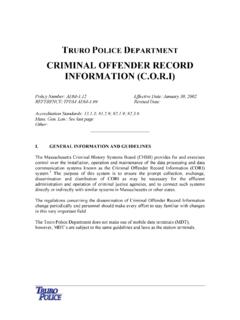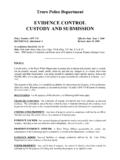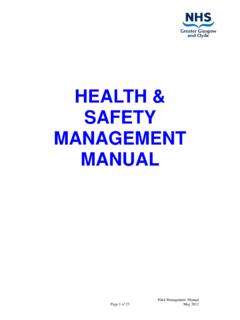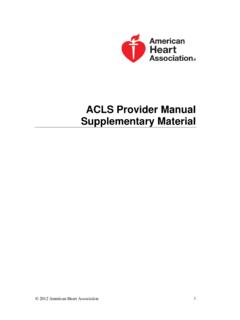Transcription of DEALING WITH THE MENTALLY ILL
1 Truro Police DepartmentDEALING with THE MENTALLY ILL Policy Number: Effective Date: April 14, 2007 REFERENCE:Accreditation Standards: Mass. Gen. Law Chap. Ch. 123, 12 Other:_____ The purpose of this policy is to provide guidance to Truro Police Officers when deal-ing with suspected MENTALLY ill persons. DEALING with individuals who are known or suspected to be MENTALLY ill is always difficult as it carries the potential for violence, requires an Officer to make difficult judgments about the mental state and intent of the individual, and requires the em-ployment of special police skills and abilities needed to effectively and legally deal with the person so as to avoid unnecessary violence and potential civil litigation. Given the unpredictable and sometimes violent nature of the MENTALLY ill, Officers should take care to never compromise or jeopardize their safety or the safety of oth-ers when DEALING with individuals displaying symptoms of mental illness.
2 The fol-lowing guidelines are provided to assist Officers in determining whether a person's behavior is indicative of mental illness, and DEALING with MENTALLY ill people in a con-structive and humane OF MENTAL ILLNESS. A subject may be suffering from mental illness if he/she displays an inability to think rationally, exercise adequate control over behavior or impulses ( , aggressive, sui-cidal, homicidal, sexual), and/or take reasonable care of his/her welfare with regard to basic provisions for clothing, food, shelter, or ABNORMAL BEHAVIOR. Mental illness is often difficult for even trained professionals to define in a given in-dividual. Officers are not expected to make judgments of mental or emotional ill-ness, but rather to recognize behavior that is potentially destructive and/or dangerous to self or others. The following generalized signs and/or symptoms of behavior may be the result of mental illness or other potential causes such as reactions to narcotics, DEALING with MENTALLY DISTURBED/ILL PERSONS , or temporary emotional disturbances that are situationally motivated.
3 Offi-cers should evaluate the following and related symptomatic behaviors in the total context of the situation when making judgments about an individual's mental state and the need for intervention absent the commission of a crime. { a} OF REACTIONS. MENTALLY ill persons may show signs of strong and unrelenting fear of persons, places, or things. The fear of people or crowds, for example, may make the individual extremely reclusive or ag-gressive without apparent OF BEHAVIOR. An individual who demonstrates extremely inappropriate behavior for a given context may be MENTALLY ill. For example, a passenger who vents his/her frustration in a crowded train by physically attacking another passenger, without provocation, may be emo-tionally RIGIDITY OR INFLEXIBILITY. MENTALLY ill persons may be easily frustrated in new or unforeseen circumstances and may demonstrate inappropriate or aggressive behavior in DEALING with the SYMPTOMATIC BEHAVIOR.
4 In addition to the above, a MENTALLY ill person may exhibit one or more of the following characteristics: abnormal memory loss related to such common facts as name and home address (although these may be signs of other physical ail-ments such as injury or Alzheimer's disease); delusions and the belief in thoughts or ideas that are false, such as (delusions of grandeur, ("I am Christ. ) or paranoid delusions, ("Everyone is out to get me."), etc.; hallucinations of any of the five senses ( , hearing voices com-manding the person to act, feeling one's skin crawl, smelling strange odors, etc.); the belief that one suffers from extraordinary physical maladies that are not possible ( , persons who are convinced that their heart has stopped beating for extended periods of time, etc.); and/or extreme fright or POLICE DEPARTMENT MANUAL 2 DEALING with MENTALLY DISTURBED/ILL PERSONS DANGER.)
5 While not all MENTALLY ill persons are danger-ous, some may represent danger under certain circumstances or conditions. Officers may use the following indicators to determine whether an apparently MENTALLY ill person represents an immediate or potential danger to himself/herself, the Officer, or others: the availability of any weapons to the suspect; statements by the person that suggest to the Officer that the indi-vidual is prepared to commit a violent or dangerous act (such comments may range from subtle innuendoes to direct threats that, when taken in conjunction with other information, paint a more complete picture of the potential for violence); a personal history that reflects prior violence under similar or re-lated circumstances (the Officer may know the person s history from prior interaction or others may be able to provide such infor-mation).
6 The amount of control that the person demonstrates is significant, particularly the amount of physical control over emotions of rage, anger, fright, or agitation; signs of a lack of control include extreme agitation, inability to sit still or communicate effectively, wide eyes, and rambling thoughts and speech, clutching one's self or other objects to main-tain control, begging to be left alone, or offering frantic assur-ances that one is all right, may also suggest that the individual is close to losing control; the volatility of the environment is a particularly relevant factor that Officers must evaluate (agitators that may affect the person or a particularly combustible environment that may incite violence should be taken into account); and failure to act on a threat of violence prior to arrival of the Officer does not guarantee that there is no danger, but it does in itself tend to diminish the potential for danger.
7 with THE MENTALLY ILL. Should the Officer determine that an individual may be MENTALLY ill and a potential threat to himself/herself, the Officer, or others, or that law enforcement intervention is required for humanitarian reasons, the following actions may be taken: { c}TRURO POLICE DEPARTMENT MANUAL 3 DEALING with MENTALLY DISTURBED/ILL PERSONS request a backup Officer, and always do so in cases where the individual will be taken into custody; take steps to calm the situation; where possible, eliminate emergency lights and sirens, disperse crowds, and assume a quiet non-threatening manner when approaching or conversing with the individual; avoid physical contact, if no violence or destructive acts have occurred, and take time to assess the situation; move slowly and do not excite the disturbed person (provide reassurance that the police are there to help and that he/she will be provided with ap-propriate care); break the speech pattern of victims who talk non-stop by interrupting them with simple questions, such as asking their birth date or full name; communicate with the individual in an attempt to determine what is both-ering them (relate your concern for their feelings and allow them to vent their feelings, where possible, gather information on the subject from ac-quaintances or family members and/or request professional assistance if available and appropriate to assist in communicating with and calming the person); avoid threatening the individual with arrest or physical submission, as this may create additional fright, stress, and potential aggression.
8 Ask them if they are taking any medications and, if so, the types pre-scribed; avoid topics that may agitate the person and guide the conversation to-ward subjects that help bring the individual back to reality; and always attempt to be truthful with a MENTALLY ill individual (if the subject becomes aware of a deception, he/she may withdraw from the contact in distrust and may become hypersensitive or retaliate in anger). Officers should be aware that persons experi-encing delusions, paranoia, or hallucination might still be able to ac-curately provide information outside their false system of thoughts, including details related to observations they made or statements they heard. The interview should be conducted in a setting free of people or distractions. If possible, only one Officer should interview victims. The interview should be simple and brief, and the Officer should be patient and offer encouragement when conducting the interview.
9 { c}TRURO POLICE DEPARTMENT MANUAL 4 DEALING with MENTALLY DISTURBED/ILL PERSONS CUSTODY OR MAKING REFERRALS. Based on the overall circumstances and the Officer's judgment of the potential for violence, the Officer may provide the individual with referrals on available community mental health resources or take custody of the individual in order to seek an involuntary emergency evaluation. { }A MENTALLY ill person may be taken into custody if: he/she has committed a crime; he/she poses a substantial danger of physical harm to other persons by exhibition of homicidal or other violent behav-ior, or he/she poses a very substantial risk of physical im-pairment or injury to himself/herself (for example, by threats or attempts at suicide), or he/she is unable to pro-tect himself/herself in the community.
10 Threats or attempts at suicide should never be treated lightly. Please see In-voluntary Admissions below; or he/she has escaped or eluded the custody of those law-fully required to care for all times an Officer should attempt to gain voluntary cooperation from the Officer having contact with a MENTALLY ill person shall keep such matter confidential except to the extent that revelation is necessary during the course of official proceedings, or for conformance with Departmental procedures regarding Officer, who receives a complaint from a family member of an al-legedly MENTALLY ill person who is not an immediate threat or is not likely to cause harm to himself/herself or others, should advise such family member to consult a physician, mental health professional, or a local mental health agency for INVOLUNTARY ADMISSIONS. Although an Officer has the statutory authority to sign commitment papers in certain situations, it is always advisable to contact Emergency Medical Services (EMS) to have this function performed.














